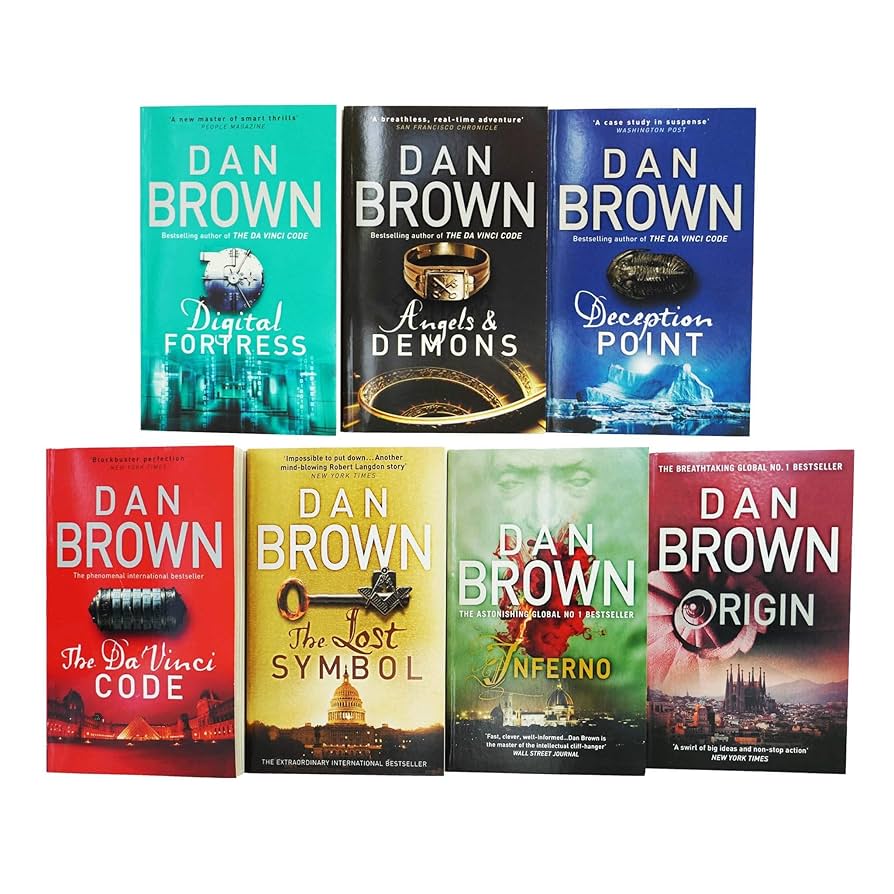Dan Brown Books in Order: A Comprehensive Guide

Dan Brown, a name synonymous with thrilling suspense and intricate puzzles, has captivated millions of readers worldwide. His novels, a masterful blend of history, symbolism, and conspiracy, have earned him a prominent place in the literary landscape. This comprehensive guide explores Dan Brown’s works, delving into the order of his books, their key themes, and their significant cultural impact. We’ll examine his celebrated Robert Langdon series, his standalone novels, and even his foray into children’s literature, providing a complete picture of his literary contributions.
The Robert Langdon Series: A Journey Through Symbolism and Intrigue

Dan Brown’s most renowned creation, Robert Langdon, a Harvard symbologist, stars in a series of interconnected novels that delve into the depths of history, religion, and secret societies. Reading the Robert Langdon books in order allows for a richer understanding of Langdon’s character development and the recurring themes that weave throughout the series. The order is crucial for appreciating the evolution of Langdon’s expertise and the interconnected narratives.
-
Angels & Demons (2000): This gripping thriller introduces Robert Langdon as he races against time to prevent a catastrophic attack by a secret society on the Vatican City during the papal conclave. The novel explores the conflict between science and religion, a recurring theme in Brown’s work.
-
The Da Vinci Code (2003): Langdon’s second adventure plunges him into a world of ancient secrets and religious conspiracies surrounding the Holy Grail and the lineage of Jesus Christ. This book propelled Brown to international stardom, sparking widespread debate and discussions about history and religious interpretation.
-
The Lost Symbol (2009): This installment takes Langdon to Washington, D.C., where he encounters a dangerous game involving Freemasonry and a hidden conspiracy within the nation’s capital. The novel explores the power of symbols and their influence on society and human behavior.

-
Inferno (2013): In Florence, Italy, Langdon finds himself suffering from amnesia, pursued by shadowy figures and embroiled in a plot that threatens to unleash a devastating plague upon the world. This book delves into the complex relationship between humanity and overpopulation.
-
Origin (2017): Langdon’s latest adventure takes him to the Guggenheim Museum Bilbao where a groundbreaking scientific discovery challenges our fundamental understanding of life’s origins. The novel confronts the ethical and existential implications of scientific advancements.
Standalone Novels: Exploring Diverse Themes and Narrative Styles
While the Robert Langdon series remains Brown’s most popular work, he has also penned several successful standalone novels that showcase his versatility as a writer. These books explore different themes and narrative styles, offering a varied reading experience for fans.

-
Digital Fortress (1998): Published before the Robert Langdon series, this techno-thriller focuses on Susan Fletcher, a brilliant cryptographer working for the National Security Agency, who discovers a powerful encryption system that poses a significant threat to global security. This novel displays Brown’s early fascination with technology and its potential for both good and evil.
-
Deception Point (2001): A political thriller centered on a fabricated scientific discovery in the Arctic, this novel features a complex plot involving government conspiracies and the lengths people will go to for power and recognition. It displays Brown’s ability to craft intricate plots involving deception and hidden motives.
Children’s Book: A Different Kind of Storytelling
Dan Brown’s foray into children’s literature with Wild Symphony (2020) is a testament to his creativity. This picture book, illustrated by Susan B. Norton, tells a delightful story that introduces children to the world of classical music and wildlife through a combination of words and vibrant illustrations. It showcases a different facet of Brown’s storytelling, demonstrating his ability to reach a wider audience with his creative ideas.
Dan Brown’s Writing Style and Inspirations
Brown’s writing style is characterized by fast-paced narratives, meticulously researched historical details, and intricate puzzles that keep readers engaged. He masterfully blends fact and fiction, creating a unique blend of realism and suspense. His inspirations are drawn from a range of sources, including his background in symbology and a lifelong fascination with science, religion, and history, evident in the detailed research and historical elements seamlessly integrated into his narratives.
Dan Brown’s Cultural Impact and Legacy
The immense popularity of Dan Brown’s novels has had a significant cultural impact. His books have spurred discussions about history, religion, art, and science, triggering public interest in Leonardo da Vinci, early Christian history, and secret societies. The Da Vinci Code, in particular, became a global phenomenon, boosting tourism in locations featured in the novel and creating a significant cultural footprint. The film adaptations of his Robert Langdon series have further broadened his reach, bringing his captivating stories to a wider audience.
Dan Brown Books: A Reading Order Suggestion
While many of Dan Brown’s books can be enjoyed as standalone novels, for a truly comprehensive experience, consider these reading order suggestions:
Option 1: Chronological Order (Publication Date):
- Digital Fortress (1998)
- Deception Point (2001)
- Angels & Demons (2000)
- The Da Vinci Code (2003)
- The Lost Symbol (2009)
- Inferno (2013)
- Origin (2017)
- Wild Symphony (2020)
Option 2: Robert Langdon Series First:
- Angels & Demons (2000)
- The Da Vinci Code (2003)
- The Lost Symbol (2009)
- Inferno (2013)
- Origin (2017)
- Digital Fortress (1998)
- Deception Point (2001)
- Wild Symphony (2020)
This approach allows you to immerse yourself fully in the world of Robert Langdon before exploring other themes in Dan Brown’s impressive repertoire.
Ultimately, the best reading order depends on individual preferences. Whether you choose chronological order or prioritize the Robert Langdon series, exploring the works of Dan Brown promises a thrilling and intellectually stimulating journey into worlds both real and imagined.